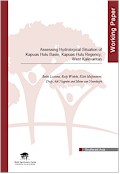| Working Paper Series |
 |
|
| Title | Assessing Hydrological Situation of Kapuas Hulu Basin, Kapuas Hulu Regency, West Kalimantan | | Author | Betha Lusiana, R Widodo, Elok Mulyoutami, Dudy Kurnia Nugroho Adi and Meine van Noordwijk | | Year | 2008 | | Publisher | World Agroforestry Centre - ICRAF, SEA Regional Office | | City of Publication | Bogor, Indonesia | | Series Number | Working Paper No. 57 | | Number of Pages | 67 | | Call Number | WP0092-08 | | Keywords | environmental services assessment, environmental services reward mechanisms hydrological modelling, Indonesia, local knowledge, watershed function |
|
| Abstract: |
| This report presents results of a ‘rapid appraisal’ of the hydrological situation in Kapuas Hulu Basin, Kapuas Hulu Regency in West Kalimantan (Indonesia). The main objective of this study was to assess the hydrological situation of Kapuas Hulu Basin and to provide information on what and where the payment for watershed services could be focused. In the upstream of Kapuas Hulu Basin lies Batang Kerihun National Park, one of the last frontiers of natural habitat in Kalimantan. The National Park is a hot-spot biodiversity area containing thousands of different plant and animal species, many of them endemic to Kalimantan.
Kapuas Hulu has a very wet climate, with an average annual rainfall of 4100 m/year. Rainfall is evenly distributed throughout the year with the wettest month in November or December. The dominant land cover class in Kapuas Hulu Basin is forest (90%). Lands that are managed by farmers (in form of agriculture and tree-based systems) only formed around 3% of the total area. There are three main catchments in Kapuas Hulu Basin: Sibau, Mendalam and Kapuas (Koheng). The intensity of land management varies between catchments, with Sibau the most intensive (vegetable plots, tree-systems and tembawang) and Kapuas the least intensive (gathering forest products and tembawang).
Currently, forest areas in Kapuas Hulu are under threat of being lost and fragmented due to fire, logging and mining activities. The local stakeholder (local community and policy makers) are concerned about the impact of loss of forest cover on watershed hydrological functions, particularly on water level and water quality (erosion, sedimentation and pollution). Boats are the main transportation for people in the area, thus stable and sufficient river depth is desirable. Water quality issues in the area are related to water turbidity due to erosion and sedimentation, as well as pollution.
The hotspots areas of Kapuas Hulu Basins are in Sibau Hulu village of Sibau catchment and Datah Dian village of Mendalam Catchment. These villages are the most upstream villages in the basin and the location where most land use change by local communities are occurring.
The average annual precipitation in the Kapuas Basin is approximately 4100 mm/year. The landscape water balance in Kapuas indicated that around 60% flows into the river, while 40% is used by the vegetation in interception and transpiration. According to the model, only 0.5 % of rainfall come as surface run-off, 16% as soil quick flow (interflow; reaching the river within 2 days after the rain) and 39% as base flow.
Based on existing data and the estimated water balance through a modelling approach, the Kapuas Hulu basin is currently still able to maintain its watershed function, particularly those related to maintaining river flow.
As indicated by the result of scenario analysis, reducing forest cover in the area will increase surface runoff and reduce soil quick flow. Thus, if the riparian zones are not healthy, there will also be increase of sedimentation in the river. The landscape water balance analysis also showed that up to 2004, the runoff fraction in Kapuas Hulu Basin was low. However, there were already signs of degradation at smaller scale as shown in the result of scenario analysis in the D
atah Dian sub-catchment. In this sub-catchment, around 3% of total rainfall becomes surface run off or amounting to 6 times the overall basin condition.
The hydrological study also looked into the effect of the changes in forest cover into other land uses (agriculture systems, bush-fallow) to the total water balance, particularly the shift from base flow into soil quick flow or surface run off. These changes will have influence on the temporal pattern of river flow at a daily basis, but not on the weekly or monthly patterns.
Future development of reward mechanisms in the area could be linked to activities that improve the (i) tree cover along river banks as well as (ii) converting non-productive land, as these areas are contributing to sedimentation in the river. The lack of existing hydrological data shows the important part of water and river monitoring activities in the overall scheme.
To ensure that the hydrological condition of Kapuas Hulu basin can be maintained or improved, attention should be paid also to large logging activities as well as gold mining activities. |
|